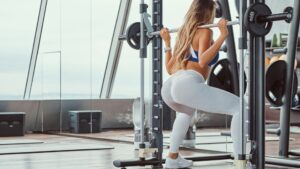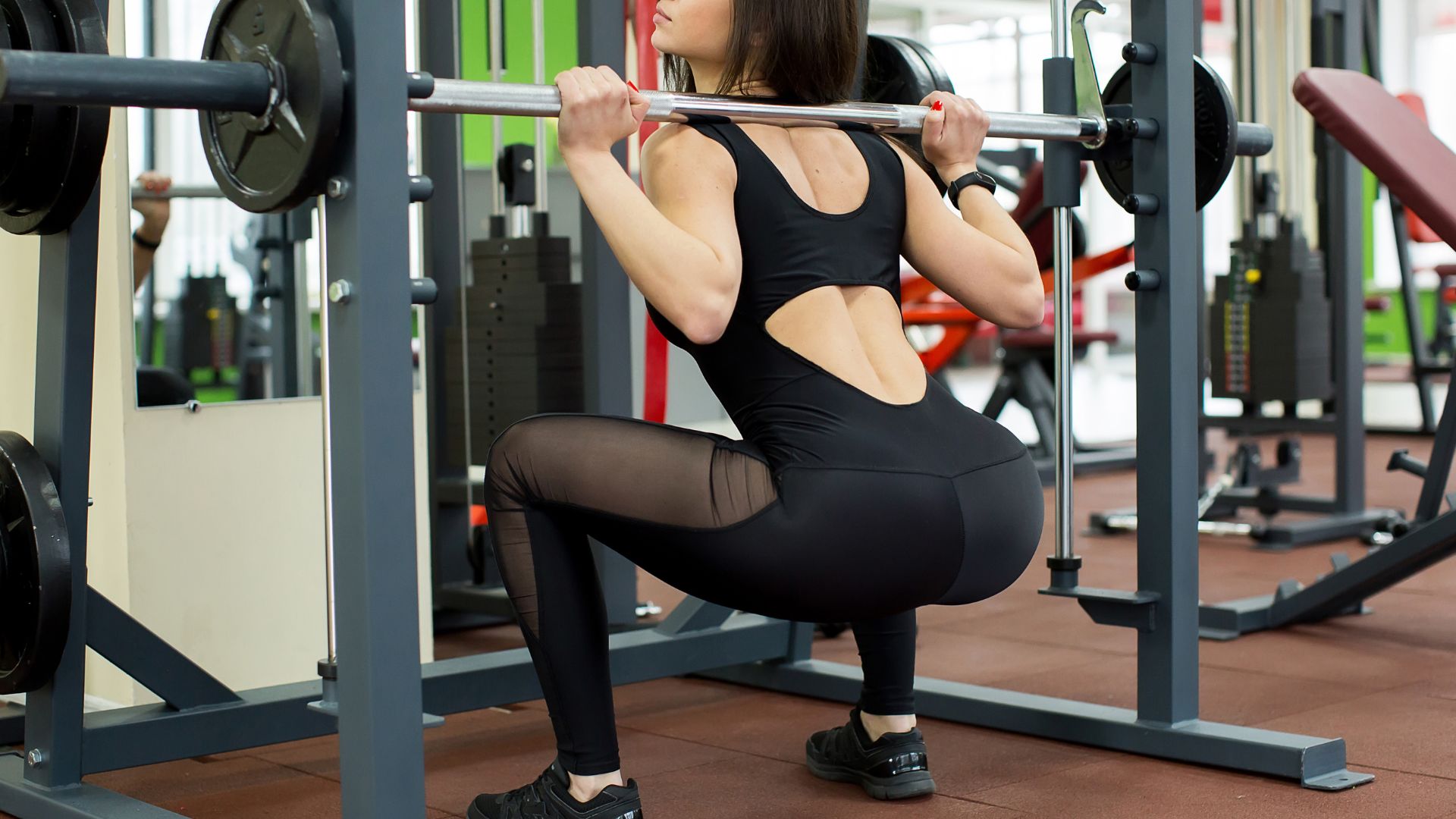Are 50 squats in a row with a Smith machine a shortcut to dream-worthy glutes or a recipe for disaster? It’s a question that often divides fitness enthusiasts.
In this blog post, we’ll dive deep into this heated debate, exploring the pros and cons of this high-repetition workout and how it can impact those sought-after glutes.
So, whether you’re a gym regular or a fitness newbie, let’s unravel the truth about whether this popular exercise is a friend or foe to your glute gains.
Understanding whether or not Is doing 50 squats in a row with a Smith machine bad for the glutes.
Yes, if not done correctly, and No, if done the right way. Doing 50 squats in a row with a Smith machine can have both benefits and drawbacks for your glutes, depending on various factors including your form, goals, and overall fitness level.
Let’s break it down here:
Form and Technique: Proper form is essential to prevent injury and maximize the benefits of squats.
If you maintain good form throughout the set, it can be an effective way to target your glutes.
The Smith machine can provide stability and assist with balance, which can help you focus on your glute muscles.
Volume and Intensity: Doing 50 squats in a row is a high-volume, endurance-based workout. While this can help build muscular endurance and burn calories, it may not be the most efficient way to build significant muscle mass in the glutes.
For hypertrophy (muscle growth), you might want to focus on heavier weights with fewer repetitions.

Variation: Repeatedly doing the same exercise can lead to a plateau in progress.
To continually challenge your glutes, it’s a good idea to incorporate a variety of exercises into your routine, including lunges, deadlifts, and Bulgarian split squats.
Warm-Up and Recovery: Such a high-volume squat session can put a lot of stress on your glutes.
Ensure you warm up adequately and perform stretches or foam rolling afterward to prevent muscle tightness and injury.
Individual Factors: Everyone’s body is different. Some people may tolerate high-repetition squats well, while others may find it causes discomfort or overuse injuries in the glutes or other muscles.
Listen to your body and adjust your training accordingly.
Goals: Your fitness goals play a significant role.
If your primary goal is endurance or fat burning, 50 squats in a row with a Smith machine can be effective.
However, if you aim for muscle growth, you may want to incorporate heavier weights and lower repetitions.
In essence, doing 50 squats in a row with a Smith machine can be beneficial for your glutes if performed with proper form and as part of a well-rounded workout routine.
However, it’s important to consider your goals, mix up your exercises, and pay attention to your body’s signals to prevent overuse injuries and achieve balanced muscular development. Consulting with a fitness professional can also help tailor your workout to your specific needs and goals.
Further Explanations.
Let’s dive deeper and elaborate further on all the points mentioned.
First let’s delve into more detail about the concepts of form and technique, as well as volume and intensity in the context of doing 50 squats in a row with a Smith machine:
Form and Technique.
Proper form and technique in any exercise are crucial for several reasons:
Injury Prevention:
Maintaining proper form reduces the risk of injury. In the case of squats, good form ensures that your joints are in alignment, reducing stress on the knees, hips, and lower back.
Muscle Engagement:
Proper form ensures that the target muscles, in this case, the glutes, are effectively engaged. It also helps distribute the workload evenly among the muscles involved in the exercise.
Efficiency:
When you perform squats with correct form, you get the most benefit out of each repetition. This means that each squat contributes effectively to your fitness goals.
Using a Smith machine can assist with form and technique in the following ways:
Stability:
The Smith machine provides a guided vertical path for the barbell, reducing the need for balancing the weight. This stability can be especially helpful for beginners or those with balance issues.
Controlled Movement:
The machine allows you to control the weight more easily, which can help you focus on the movement and your muscle engagement without worrying about the barbell’s lateral movement.
Volume and Intensity:
Volume:
Doing 50 squats in a row constitutes a high-volume workout. This means you are performing a large number of repetitions.
High-volume workouts are excellent for building muscular endurance, which means your muscles can sustain activity for an extended period.
Intensity:
The intensity of an exercise refers to how heavy the weight is in relation to your one-repetition maximum (1RM).
In this case, doing 50 squats with a Smith machine is likely to be done with a moderate weight for you since the goal is endurance rather than lifting a very heavy load.
When it comes to building significant muscle mass in the glutes (hypertrophy), higher intensity is often favored.

This typically involves lifting heavier weights for fewer repetitions. The idea is to create enough muscle damage and stress to promote growth during the recovery phase.
In all this, using proper form and technique is vital to ensure safety and maximize the effectiveness of any exercise, including squats.
A Smith machine can assist in maintaining stability and balance during squats.
However, doing 50 squats in a row is more of an endurance-focused workout, which is beneficial for building muscular endurance and burning calories but may not be the most efficient method for significant muscle growth in the glutes.
For hypertrophy, you may want to incorporate heavier weights with fewer repetitions into your routine.
let’s explore the importance of variation in your exercise routine and the significance of warm-up and recovery when doing high-volume squat sessions:
Variation.
Repeating the same exercise, such as squats, over an extended period can lead to a plateau in progress.
This occurs because your body adapts to the specific stresses of that exercise, and the muscles involved may become more efficient at performing it.
To continually challenge your glutes and other muscle groups while avoiding plateaus, it’s a good idea to incorporate exercise variation into your routine. Here’s why:
Target Different Muscle Fibers:
Different exercises place varying levels of stress on different muscle fibers and angles.
By incorporating a variety of exercises, you engage a broader spectrum of muscle fibers within the glutes, leading to more balanced and comprehensive muscle development.
Prevent Overuse Injuries:
Repeatedly performing the same exercise can increase the risk of overuse injuries, as specific muscle groups and joints may bear the brunt of the strain.
Varying exercises allows these muscles to recover while others take the lead in subsequent workouts.
Mental Stimulation:
Variety keeps your workouts interesting and mentally stimulating, reducing the risk of boredom and improving adherence to your fitness routine.
Examples of exercises to add variety to your glute workouts, as mentioned earlier, include:
Lunges:
Lunges involve stepping forward or backward and can target different parts of the glutes depending on the variation (e.g., forward lunges, reverse lunges, or walking lunges).
Deadlifts:
Deadlifts work not only the glutes but also the hamstrings and lower back, providing a comprehensive lower body workout.
Bulgarian Split Squats:
These are single-leg squats performed with one foot elevated behind you, placing a unique demand on the glutes and improving balance.
Warm-Up and Recover.
Warm-up and recovery are essential aspects of any workout routine, especially when you’re engaging in a high-volume squat session. Here’s why they are crucial:
Warm-Up:
A proper warm-up gradually increases your heart rate and body temperature, preparing your muscles and joints for the upcoming exercise.
For squats, a dynamic warm-up that includes leg swings, hip circles, and bodyweight squats can help activate the glutes and reduce the risk of injury.
Preventing Muscle Tightness:
High-volume squats can lead to muscle tightness and soreness. After your workout, stretching and foam rolling can help relieve muscle tension and maintain flexibility in your glutes and surrounding muscles.
Injury Prevention:
Adequate warm-up and post-workout recovery reduce the risk of injuries, including strains and muscle imbalances.
Optimal Performance:
A proper warm-up and recovery routine can enhance your performance during the workout and contribute to better overall results.
In summary, incorporating exercise variation into your routine helps prevent plateaus and promotes balanced muscle development.
Additionally, paying attention to warm-up and recovery practices is essential for injury prevention and maintaining flexibility and function in your glutes and lower body muscles, especially after high-volume workouts like 50 squats in a row.
let’s delve deeper into the individual factors and fitness goals that should influence your approach to doing 50 squats in a row with a Smith machine:
Individual Factors.
Body Variability:
Every person’s body is unique. Factors like your fitness level, biomechanics, flexibility, and any preexisting conditions can impact how your body responds to high-repetition squats.
Some individuals may have the mobility and muscular endurance to perform 50 squats without issues, while others might experience discomfort or even overuse injuries.
Listen to Your Body:
It’s crucial to pay attention to how your body responds to the exercise. If you feel pain, discomfort, or any unusual sensations in your glutes or elsewhere, it’s a sign that you should adjust your training.
Pushing through pain can lead to injuries, so it’s essential to prioritize your body’s signals for safety and long-term progress.
Progressive Overload:
Your ability to tolerate high-repetition squats may improve over time as your muscles adapt. However, this should be a gradual process to avoid overtraining or injury.
It’s advisable to start with a manageable number of repetitions and progressively increase them as your strength and endurance improve.
Goals.
Endurance and Fat Burning:
If your primary fitness goals are to improve endurance or burn fat, a workout like 50 squats in a row can be effective.
Such high-repetition, endurance-based training elevates your heart rate and burns a significant number of calories, contributing to improved cardiovascular fitness and fat loss.
Muscle Growth (Hypertrophy):
On the other hand, if your goal is to build significant muscle mass in your glutes, this typically requires a different approach.
Muscle growth, or hypertrophy, is best stimulated by lifting heavier weights with fewer repetitions.
This creates the necessary muscular tension and damage for muscle fibers to grow during the recovery phase.
For hypertrophy, incorporating weighted squats with a Smith machine or free weights and aiming for lower repetitions (e.g., 6-12 reps) might be more effective.
In summary, individual factors, including your body’s response and your fitness goals, should guide your approach to doing 50 squats in a row with a Smith machine or any exercise. Always prioritize safety and listen to your body’s signals.
If you’re unsure about the best approach for your specific goals and physical condition, consulting with a fitness professional or personal trainer can provide you with personalized guidance and recommendations tailored to your needs.
A concise tabular on this topic here.
Here’s a concise tabular summary on the topic of doing 50 squats in a row with a Smith machine and its impact on the glutes:
| Aspect | Impact on Glutes with 50 Squats in a Row |
|---|---|
| Form and Technique | Can be beneficial if maintained properly, focusing on glute engagement. |
| Volume and Intensity | High-volume, endurance-based, suitable for muscular endurance and calorie burn, less effective for significant muscle growth (hypertrophy). |
| Variation | Repeating the same exercise can lead to plateaus; incorporating exercise variety is important for balanced muscle development. |
| Warm-Up and Recovery | Adequate warm-up and post-workout recovery are essential to prevent injury and muscle tightness. |
| Individual Factors | Body variability matters; some may tolerate it well, while others might experience discomfort or overuse injuries. Listen to your body and adjust training accordingly. |
| Goals | Effective for endurance and fat burning; for muscle growth (hypertrophy), heavier weights and lower repetitions are typically more suitable. |
This table provides a quick overview of the key considerations when performing 50 squats in a row with a Smith machine and how it affects the glutes based on various factors and fitness goals.
Conclusion.
In conclusion, doing 50 squats in a row with a Smith machine can have both benefits and potential drawbacks for the glutes.
Proper form and technique are crucial for maximizing benefits, but it’s essential to consider individual factors, fitness goals, and the need for exercise variation.
This high-volume approach is effective for endurance and fat burning but may not be the most efficient for significant glute muscle growth.
Balancing your workout routine with heavier weights and lower repetitions, along with proper warm-up and recovery, is important for a well-rounded approach to glute training.

Hey there, it’s Mike Rrsq, the Editor-in-Chief over at Jsquat.com, and I’m absolutely obsessed with all things squat fitness! I’ve been lucky enough to get some serious recognition for my work in this field. With a solid background in the fitness and wellness industry, I’ve been there right from the get-go, helping shape this website into what it is today.
You see, I’m not just the boss around here; I’m also a passionate contributor. I love sharing my insights through my articles, and trust me, they’re not your run-of-the-mill stuff. Each piece I write is a labor of love, filled with my expertise and real-world experience in the fitness universe. So, if you’re into fitness and looking for some inspiration, you’re in the right place!

